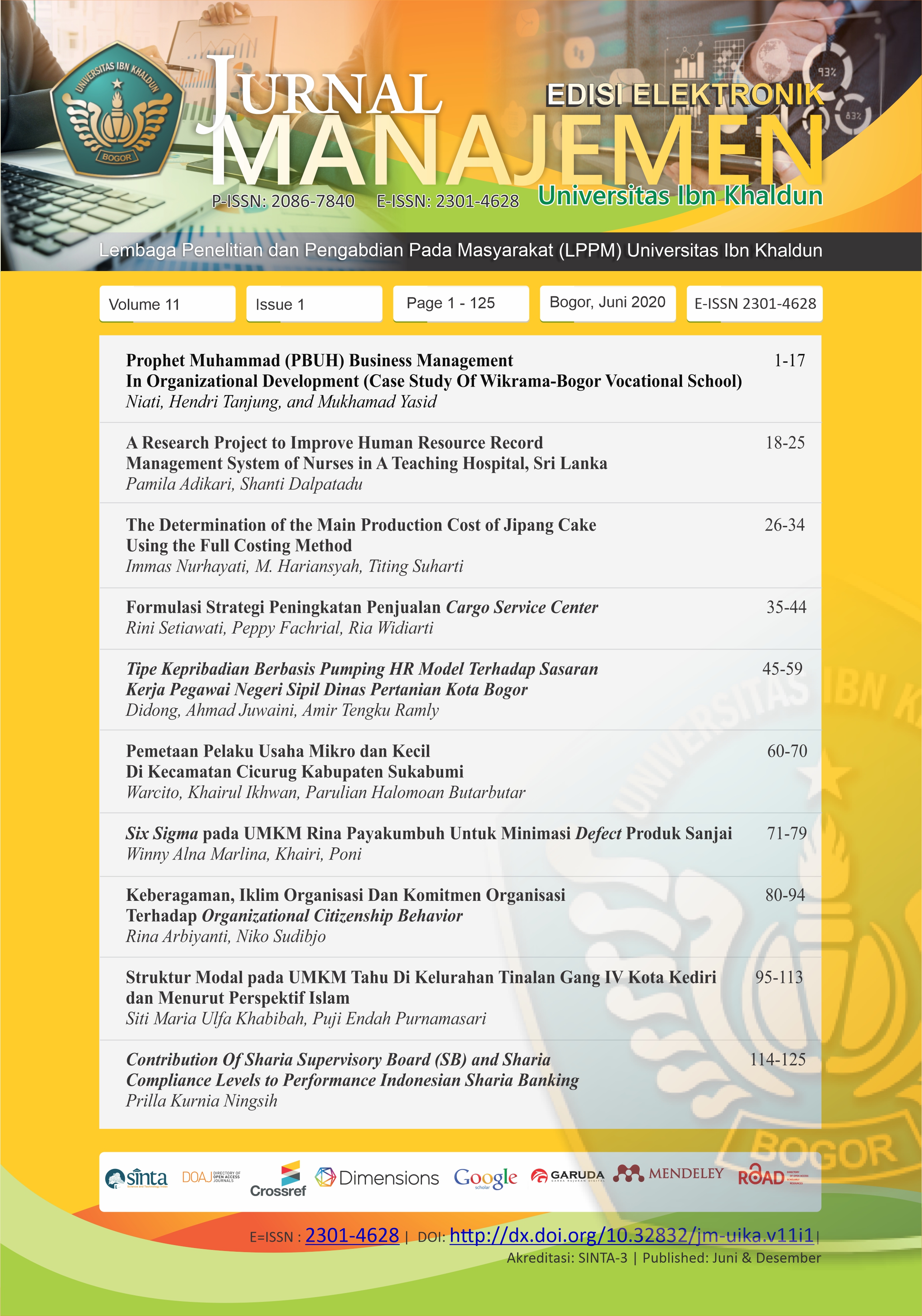Six Sigma pada UMKM Rina Payakumbuh Untuk Minimasi Defect Produk Sanjai
DOI:
https://doi.org/10.32832/jm-uika.v11i1.2647Keywords:
Six Sigma, Quality Control, ParetoAbstract
Based on Survey data in 2018, Payakumbuh has a cracker industry of 44%, a wet cake industry 37%, 11% of the food industry which is not yet included in any group, and 8% of the bread and similar industries. One of the SMEs that produce Sanjai in Payakumbuh is Sanjai Rina. Sanjai Rina's business has been established since 1990. The production system at Sanjai Rina is still simple in its processing, so there are defective products every month. The number of defects in December 2018 will be 50 kg, with a production of 3300 kg. For this reason, Six Sigma at Rina Payakumbuh MSMEs for Minimizing Defect Sanjai Products. The use of Six Sigma to prevent and reduce product defects, save costs, and customer satisfaction. Results Sigma scores of Sanjai defective products at Rina's UMKM were 4% and exceeded Sigma's standard by 3%. In minimizing defects in Sanjai products by using the Six Sigma methodology, which includes DMAIC. Sanjai Rina's product damage classification consists of 32% because the packaging is caused by plastics exposed to the heat of the frying pan, 29.8% due to expired products, and 38.2% technical problems, namely a large number of requests by the retailer due to running out of stock. Technical errors cause the most significant product defect, so UKM Rina will provide training to employees and provide training in producing sanjai to minimize the number of defective products to increase company profits.
References
BPS Kota Payakumbuh. (2017). Statistik Kesejahteraan Rakyat Kota Payakumbuh. Katalog : 4101002.1376, 1–188.
Dewi, S. K. (2012). Minimasi defect produk dengan konsep six sigma. Jurnal Teknik Industri, 13(1), 43-50.
Didiharyono, D., Marsal, M., & Bakhtiar, B. (2018). Analisis Pengendalian Kualitas Produksi Dengan Metode Six-Sigma Pada Industri Air Minum PT Asera Tirta Posi-donia, Kota Palopo. Sainsmat: Jurnal Il-miah Ilmu Pengetahuan Alam, 7(2), 163-176.
Elza Alam Santosa, F. (2017). Analisis Six Sigma untuk Mengurangai Jumlah Cacat Sepatu di PT. Primarindo Asia Infrastruc-ture, Tbk. Prosiding SAINTIKS FTIK UNIKOM, 2.
Emilasari, D., & Vanany, I. (2007). Aplikasi six sigma pada produk clear file di perus-ahaan stationary. Jurnal Teknik Indus-tri, 9(1), 27-36.
Ganguly, K. (2012). Improvement process for rolling mill through the DMAIC six sigma approach. International Journal for quality research, 6(3), 221-231.
Gygi, C., & Williams, B. (2012). Six sigma for dummies. John Wiley & Sons.
Heizer, J., & Render, B. (2009). Manajemen Operasi Buku 1 Edisi 9. Jakarta: Salem-ba, 4.
Koeswara, S., & Ardianto, H. R. (2013). Im-plementasi Six Sigma Untuk Peningkatan Kualitas Sandal Di CV. Sancu Creative In-donesia. Sinergi, 17(3), 274-280.
Koperindag Payakumbuh. (n.d.). Jenis - Jenis Usaha di Kota Payakumbuh (2017).
Knowles, G. (2011). Six Sigma. Bookboon.
Marlina, W. A., Susiana, S., Erizal, N., & Ahmad, F. A. (2018). Forecasting tech-nique using time sequence: model penen-tuan volume produksi Sanjai di UKM Rina Payakumbuh. Jurnal Manajemen (Edisi Elektronik), 9(2), 187-196.
Narula, V., & Grover, S. (2015). Six Sigma: literature review and implications for fu-ture research. International Journal of In-dustrial Engineering & Production Re-search, 26(1), 13-26.
Pahlawan, F. M., & Vanany, I. (2019). Model Six Sigma Untuk Mengurangi Produk Cacat Karena Faktor Ketidakhala-lan. Jurnal Ilmiah Teknik Industri, 18(1), 17-24.
Pyzdek, T. Keller, PA (2010). The Six Sigma Handbook: A complete guide for green-belts, black belts, and managers at all lev-els.
Rathilall, R., & Singh, S. (2018). A Lean Six Sigma framework to enhance the competi-tiveness in selected automotive component manufacturing organisations. South Afri-can journal of economic and management sciences, 21(1), 1-13.
Rimantho, D., & Mariani, D. M. (2017). Pen-erapan metode six sigma pada pengendali-an kualitas air baku pada produksi ma-kanan. Jurnal Ilmiah Teknik Indus-tri, 16(1), 1-12.
Sekaran, U., & Bougie, R. (2016). Research methods for business: A skill building ap-proach. John Wiley & Sons.
Undang - Undang Nomor 20 Tahun 2008. (2008). Kriteria Usaha Mikro, Kecil Dan Menengah Menurut UU.
Downloads
Published
How to Cite
Issue
Section
License
Authors who publish with this journal agree to the following terms:
- Authors retain copyright and grant the journal right of first publication with the work simultaneously licensed under a Creative Commons Attribution-NonCommercial-ShareAlike 4.0 International License that allows others to share the work with an acknowledgement of the work's authorship and initial publication in this journal.
- Authors can enter into separate, additional contractual arrangements for the non-exclusive distribution of the journal's published version of the work (e.g., post it to an institutional repository or publish it in a book), with an acknowledgement of its initial publication in this journal.
- Authors are permitted and encouraged to post their work online (e.g., in institutional repositories or on their website) prior to and during the submission process, as it can lead to productive exchanges, as well as earlier and greater citation of published work (See The Effect of Open Access).











